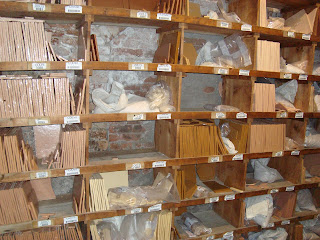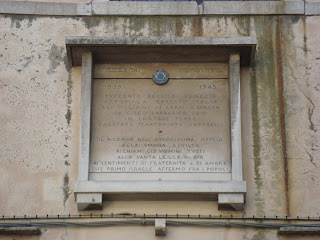Finally, a woman named Liliana led us to the studio where we claimed our workspaces and proceeded to take a tour of the grounds. Observing and learning about the process of making smalti was a chemist's dream! I was so excited to be in the furnace watching the men at work that I only caught a fraction of the explanation, but from what I could gather here's how it works: First, a gigantic clay vessel is filled with silica (sand), heated to the melting point, and various elements and minerals are added to create a specific color. At Orsoni, mosaic tile called smalti are produced in literally thousands of colors, each with its own special recipe. Once melted, the mixture is gathered into ball and transferred to a belt where it was worked and flattened, then rolled through the glass making equivalent of a pasta machine to press the glass into a large sheet. This is then cooled and ready for cutting several hours later. I'm certain I've missed a good number of steps, but you get the idea.
 |
| The ceramic vessels used for melting the glass and mixing colors. |
 |
| Mmmmm....so many beautiful colors of smalti! |
 |
| So many colors to choose from! |
 |
| Special fleshtones |
 |
| Smalti! |
 |
| Scoring the glass with a grid. |
 |
| Then breaking the glass into tiles. |
 |
| One of the ladies using a cutting machine. |
We returned to our workspaces and a whirlwind of activity ensued. Within minutes we were making decisions about the size of our pieces, receiving cut boards, and tracing our designs onto the wood. Mirta, the student coordinator and awesome translator, gave me a handful of tiles and a quick demonstration on how to use the hammer and hardie to cut the smalti into smaller pieces then watched as I practiced. It took some serious skill and concentration to balance a piece of smalti on the hardie, lift up the hammer which weighed over a kilogram, then bring the blade of the hammer down onto the glass in such a way that it split cleanly. Throughout the week there were a great deal of casualties (I'm referring to smalti tiles here!) as I continued to work at mastering these tools and I was quite thankful to walk away with all ten fingers!
 |
| Mom starting to trace her pattern onto a board. |
 |
| Tracing my design and choosing colors. |
 |
| Tools of a mosaic artist...hammer and hardie. |
I learned to mix white mortar (referred to as "glue") with black pigment and how to use a small trowel to spread the mortar onto my board (just like frosting a cake!). Antonella, our maestra, gave me a quick lesson on placing tiles to begin to create texture and movement. Who would have thought that there were SO MANY details to consider when cutting and placing tiles to form a picture? I could tell right away that creating a mosaic was going to force me to think outside of my very linear brain and would challenge my artsy-craftsy skills to the max! By lunchtime on the first day I felt that I hadn't accomplished much.
 |
| Morning progress on my piece. |
When lunchtime came around mom and I took a break to eat our sandwiches and walk around the neighborhood. We didn't know it then, but the neighborhood where we stayed, called the Canaregio, is probably as close to "authentic Venice" as you can get and I really loved it. We wandered around without a map or a destination in mind, knowing that as long as we could get back to Ponte de Guglie we would be okay. As we explored the neighborhood and made our way back to the studio, I knew that this was EXACTLY the type of vacation I needed.
 |
| Apartments in the neighborhood. |
 |
| Old, crusty, and beautiful. |
 |
| The synagogue. |
 |
| Nationalist graffiti. |
 |
| The mail slot at Orsoni. |
 |
| The colors and canals were captivating! |
 |
| Mom's mosaic at the end of the first day of class. |
 |
| My mosaic at the end of the first day of class. |
Knowing that we had a lot of progress still to make, we returned to the studio to find Astrid hard at work on her eagle mosaic. Monika and Lucia had opted to take the first night off and go out for dinner and a concert. Little did I know that these late evening sessions would be the start of a lovely friendship between myself and Astrid. We talked more than we worked, sharing chocolate and stories about our lives. I could tell there would be many fun times to be had in the coming evenings. Better still, I found myself really wanting to be in the mosaic studio hard at work instead of out in the city hitting all of the tourist spots we had put on our list of things to do.
The end of the first night brought about an important realization. We had worked in the studio for about eight hours that first day and I was really surprised how slow going the process was. Let's face it, I work slowly...I am a perfectionist to the core. This turned out to be one of my biggest challenges and learnings of the week: it is okay not to be perfect! For those of you who know me, this is not a natural way of thinking for me. I always feel like I am under some sort of scrutiny (my boss at work, the students I teach, my family and friends) and I worry so much about what others think that it can be exhausting. I want to make impeccable scrapbook pages, plan engaging lessons, write captivating blog posts, iron my clothes to perfection...I want to be able to approach a task and do it right, and well, from the get go. For the first time in a very long time I really had to let go of all of my preconceived ideas about how a mosaic comes together, accept the limitations of my beginning skills, and just allow myself to be guided by intuition, the expertise of my teacher, and my materials. In so many ways, this was such a freeing experience and I was able to really embrace the creative process. Now that I am back to my non-vacation life, I think the real challenge begins--carrying this new found freedom into the rest of my existence and finally accepting that the imperfect me is good enough...most of the time.




No comments:
Post a Comment
Leave your thoughts here...